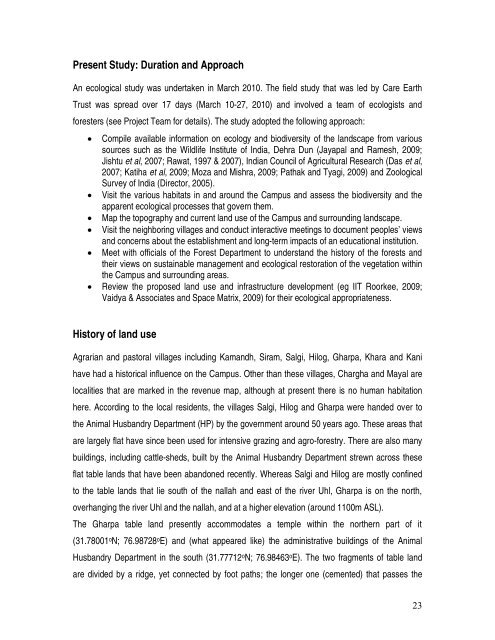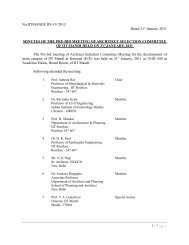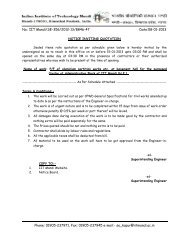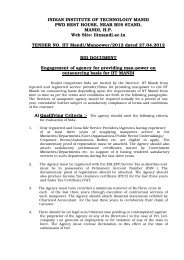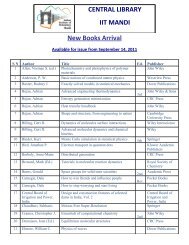Eco Report of the area - IIT Mandi
Eco Report of the area - IIT Mandi
Eco Report of the area - IIT Mandi
You also want an ePaper? Increase the reach of your titles
YUMPU automatically turns print PDFs into web optimized ePapers that Google loves.
Present Study: Duration and Approach<br />
An ecological study was undertaken in March 2010. The field study that was led by Care Earth<br />
Trust was spread over 17 days (March 10-27, 2010) and involved a team <strong>of</strong> ecologists and<br />
foresters (see Project Team for details). The study adopted <strong>the</strong> following approach:<br />
<br />
<br />
<br />
<br />
<br />
Compile available information on ecology and biodiversity <strong>of</strong> <strong>the</strong> landscape from various<br />
sources such as <strong>the</strong> Wildlife Institute <strong>of</strong> India, Dehra Dun (Jayapal and Ramesh, 2009;<br />
Jishtu et al, 2007; Rawat, 1997 & 2007), Indian Council <strong>of</strong> Agricultural Research (Das et al,<br />
2007; Katiha et al, 2009; Moza and Mishra, 2009; Pathak and Tyagi, 2009) and Zoological<br />
Survey <strong>of</strong> India (Director, 2005).<br />
Visit <strong>the</strong> various habitats in and around <strong>the</strong> Campus and assess <strong>the</strong> biodiversity and <strong>the</strong><br />
apparent ecological processes that govern <strong>the</strong>m.<br />
Map <strong>the</strong> topography and current land use <strong>of</strong> <strong>the</strong> Campus and surrounding landscape.<br />
Visit <strong>the</strong> neighboring villages and conduct interactive meetings to document peoples’ views<br />
and concerns about <strong>the</strong> establishment and long-term impacts <strong>of</strong> an educational institution.<br />
Meet with <strong>of</strong>ficials <strong>of</strong> <strong>the</strong> Forest Department to understand <strong>the</strong> history <strong>of</strong> <strong>the</strong> forests and<br />
<strong>the</strong>ir views on sustainable management and ecological restoration <strong>of</strong> <strong>the</strong> vegetation within<br />
<strong>the</strong> Campus and surrounding <strong>area</strong>s.<br />
Review <strong>the</strong> proposed land use and infrastructure development (eg <strong>IIT</strong> Roorkee, 2009;<br />
Vaidya & Associates and Space Matrix, 2009) for <strong>the</strong>ir ecological appropriateness.<br />
History <strong>of</strong> land use<br />
Agrarian and pastoral villages including Kamandh, Siram, Salgi, Hilog, Gharpa, Khara and Kani<br />
have had a historical influence on <strong>the</strong> Campus. O<strong>the</strong>r than <strong>the</strong>se villages, Chargha and Mayal are<br />
localities that are marked in <strong>the</strong> revenue map, although at present <strong>the</strong>re is no human habitation<br />
here. According to <strong>the</strong> local residents, <strong>the</strong> villages Salgi, Hilog and Gharpa were handed over to<br />
<strong>the</strong> Animal Husbandry Department (HP) by <strong>the</strong> government around 50 years ago. These <strong>area</strong>s that<br />
are largely flat have since been used for intensive grazing and agro-forestry. There are also many<br />
buildings, including cattle-sheds, built by <strong>the</strong> Animal Husbandry Department strewn across <strong>the</strong>se<br />
flat table lands that have been abandoned recently. Whereas Salgi and Hilog are mostly confined<br />
to <strong>the</strong> table lands that lie south <strong>of</strong> <strong>the</strong> nallah and east <strong>of</strong> <strong>the</strong> river Uhl, Gharpa is on <strong>the</strong> north,<br />
overhanging <strong>the</strong> river Uhl and <strong>the</strong> nallah, and at a higher elevation (around 1100m ASL).<br />
The Gharpa table land presently accommodates a temple within <strong>the</strong> nor<strong>the</strong>rn part <strong>of</strong> it<br />
(31.78001 o N; 76.98728 o E) and (what appeared like) <strong>the</strong> administrative buildings <strong>of</strong> <strong>the</strong> Animal<br />
Husbandry Department in <strong>the</strong> south (31.77712 o N; 76.98463 o E). The two fragments <strong>of</strong> table land<br />
are divided by a ridge, yet connected by foot paths; <strong>the</strong> longer one (cemented) that passes <strong>the</strong><br />
23


